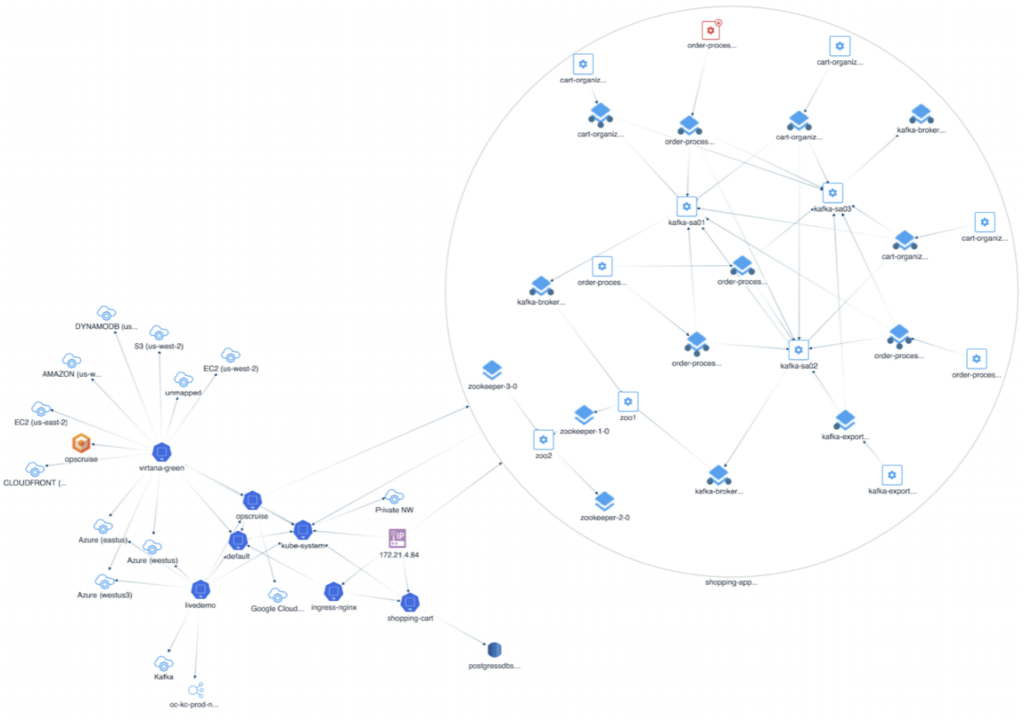Introduction
In today’s dynamic and complex IT landscapes, maintaining visibility into application topologies is crucial for ensuring optimal performance, troubleshooting issues, and delivering exceptional end-user experiences. Did you know that 73% of IT leaders report increased difficulty in managing application performance due to rising complexity? Traditional monitoring approaches often fall short, failing to provide the depth of visibility required to navigate the intricate web of interconnected applications and services. Enter Virtana Application Monitoring (AM).
The Power of eBPF
Extended Berkeley Packet Filter (eBPF) is a revolutionary technology that allows programs to run in the Linux kernel without changing kernel source code or adding additional modules. Originally designed for network packet filtering, eBPF has evolved into a powerful tool for monitoring and observability, providing granular insights into system behavior.
Origins of eBPF

Cartoon by Vadim Shchekoldin, Isovalent
eBPF was initially developed to enhance the Berkeley Packet Filter (BPF) capabilities, enabling more sophisticated packet filtering in the Linux kernel. Over time, its applications have expanded beyond networking to include tracing, monitoring, and performance analysis. eBPF programs can be dynamically loaded into the kernel, executing in a secure, sandboxed environment.
Leveraging eBPF for Topology Mapping in Virtana Application Monitoring
Virtana AM harnesses the advanced capabilities of eBPF to deliver granular topological insights, offering IT teams a comprehensive and detailed view of their application environments. By leveraging eBPF, Virtana AM can trace application interactions in real time, map dependencies accurately, and visualize the intricate relationships between services, containers, and infrastructure components. This level of visibility is crucial for modern, dynamic application environments, where components are frequently updated, scaled, and moved.
Topology Mapping Using eBPF
While eBPF provides a powerful foundation for topology mapping, it is not sufficient on its own to build a complete picture of an application’s environment. Topology building is inherently complex, requiring the integration of data from multiple sources and layers of the application stack. Virtana AM combines eBPF with other data collection methods and analysis techniques to create a detailed and actionable topology.
Example of Topology Building
Consider an example where a containerized application connects to an AWS RDS (Relational Database Service) instance:
- Container and Service Discovery: Virtana AM uses eBPF to monitor and capture communication patterns between containers and services running within the infrastructure. For instance, a microservice responsible for user authentication might be making calls to an AWS RDS instance to verify credentials.
- Dependency Mapping: By analyzing captured data, Virtana AM maps out the dependencies between the application components. It can show how the authentication microservice relies on the RDS instance and how this interaction affects the performance of the entire application.
- Performance Metrics: eBPF enables the collection of detailed performance metrics, such as latency, throughput, and error rates, for the interactions between containers and external services. Virtana AM uses these metrics to provide insights into the health and performance of the application components. For example, if there is a spike in latency during login attempts, IT teams can quickly identify the RDS instance as the bottleneck.
- Visualizing Relationships: Virtana AM visualizes these dependencies and interactions in a dynamic topology map. This map illustrates the relationships between various components, such as how the front-end service communicates with multiple back-end services, which in turn interact with databases and other external services. This visualization helps IT teams quickly understand the impact of each component on the overall system.

Seamless Troubleshooting and Performance Optimization
Virtana AM’s eBPF-based topology allows IT teams to troubleshoot issues and optimize performance seamlessly. By offering a clear view of application dependencies and performance metrics, Virtana AM enables teams to quickly pinpoint the root cause of problems and address them effectively. Whether it’s a misconfigured service, a slow database query, or network latency, the detailed insights provided by eBPF empower IT teams to take proactive measures to maintain optimal performance.
Navigating Complex Environments with Ease
As application environments become increasingly complex, understanding and managing these environments is more critical than ever. Virtana AM simplifies this process by providing a comprehensive and intuitive view of your entire application landscape. By integrating data from eBPF and other monitoring tools, Virtana AM offers a holistic approach to observability, ensuring that IT teams have all the information they need to keep their applications running smoothly.
Case Study: Real-World Application
Consider a leading innovator in electric vehicles and energy solutions using Virtana AM to monitor their software systems. Their applications, ranging from in-car software to back-end services supporting their network, are highly complex and interconnected. By leveraging eBPF-based topology, they identified a performance bottleneck caused by a high-latency connection between their vehicle software update service and their central data repository. With the detailed insights provided by Virtana AM, their IT team re-architected their service interactions to optimize performance, resulting in faster software updates and improved reliability for their customers. This enhanced the user experience and ensured their systems could scale efficiently to meet growing demand.
Conclusion
Virtana AM’s use of eBPF for topology mapping offers unparalleled visibility into application environments. By combining eBPF with additional data sources and advanced analysis techniques, Virtana AM provides IT teams with the tools they need to understand, monitor, and optimize their complex, dynamic application landscapes. The result is enhanced performance, faster troubleshooting, and a more robust and reliable IT environment.
Ready to unleash the power of deep observability in your application environment? Explore Virtana AM today and see how eBPF-based topology mapping can transform your IT operations. Visit Virtana AM to learn more and start your free trial.
About the Author
Yash Shah is a Lead PM at Virtana in the observability space, with over a decade of experience in the SaaS space. As a key contributor to the Application Monitoring offering, Yash Shah is dedicated to helping organizations achieve deeper visibility and control over their application environments.
References:
1. eBPF: A Revolutionary Technology for Observability” by Brendan Gregg
3. “Understanding the Power of eBPF for Systems Observability” by Sysdig
4. eBPF: A Game-Changer for Monitoring and Networking” by Red Hat
5. eBPF: The Future of Networking and Observability
6. Understanding Application Performance with eBPF
7. Cartoon by Vadim Shchekoldin, Isovalent and sourced by Philipp Meier and Thomas Graf: ebpf.io
8. Case Studies: How eBPF is Transforming IT Operations
Yash Shah




